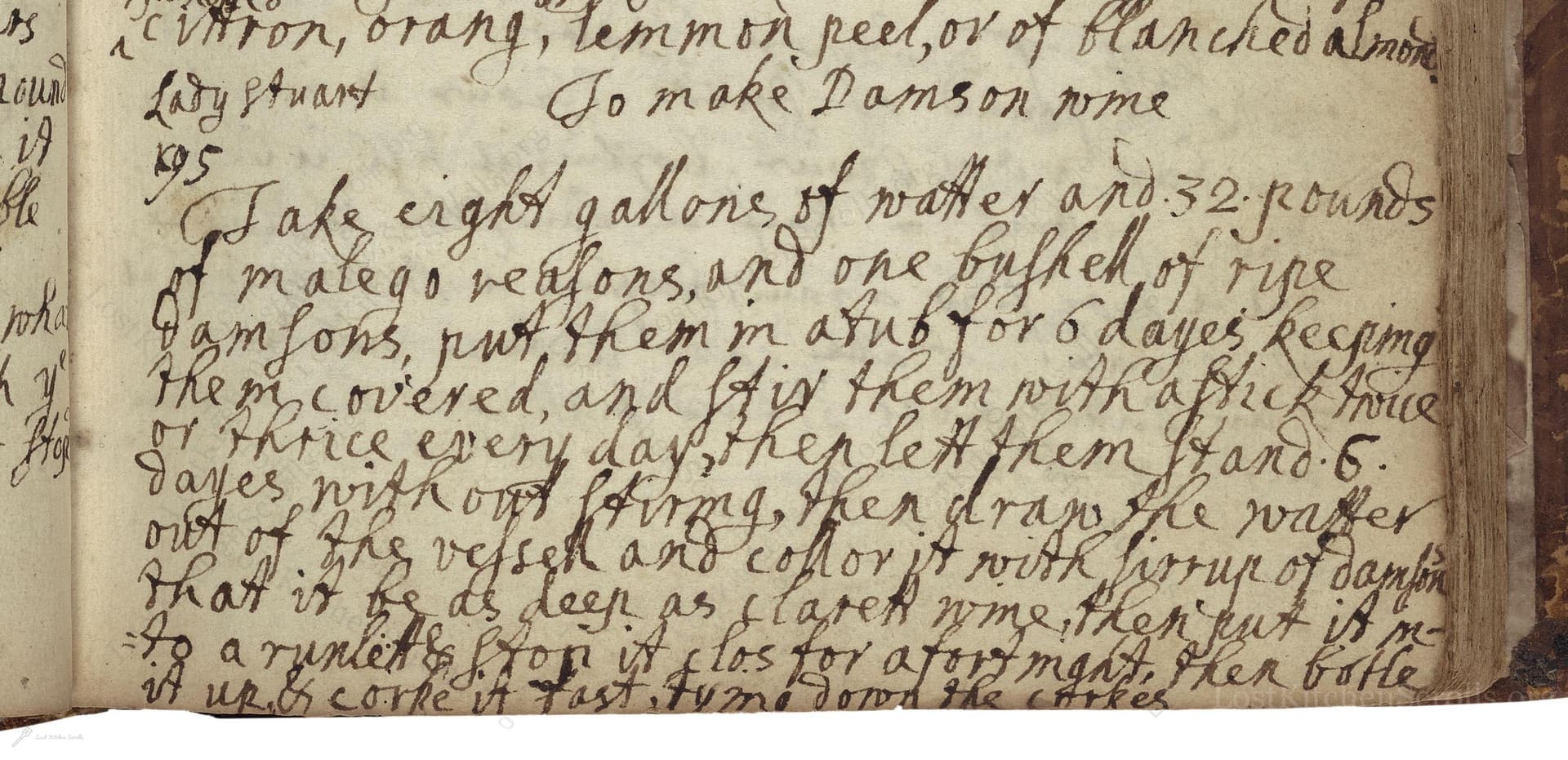To Make Damson Wine
From the treasured pages of Receipt book of Penelope Jephson
Written by Penelope Patrick

To Make Damson Wine
"Take eight gallons of watter and 32 pounds of malego reasons, and one bushell of ripe damsons, put them in a tub for 6 dayes keeping them covered, and stir them with a stick twice or thrice every day, then let them stand 6 dayes without stiring, then draw the watter out of the vessel and color it with syrrup of damson that it be as deep as claret wine, then put it into a runlet & stop it clos for a fortnight, then botle it up & corke it fast. turne downe the corkes."
Note on the Original Text
The recipe follows the convention of 17th-century English manuscript cookery—providing loose instructions, assuming that the reader has some familiarity with methods like fermentation and bottling. Spelling such as 'watter' for water, 'dayes' for days, 'clos' for close, and 'botle' for bottle reflects contemporary pronunciation and orthography. Directions are direct but sparse, prioritizing process and trust in the cook's intuition. The reference to coloring the wine with syrup, 'as deep as claret,' signals both the desired hue and the influence of fashionable French wines of the period. Quantities are approximate but generous, showing both a lack of precise measurement tools and confidence in the robust nature of the process.

Title
Receipt book of Penelope Jephson (1673)
You can also click the book image above to peruse the original tome
Writer
Penelope Patrick
Era
1673
Publisher
Unknown
Background
Step back into the sumptuous kitchens of the late 17th century with Penelope Patrick’s culinary collection—a feast of historic recipes, secret tips, and the irresistible flavors of Restoration England all bound together in a handwritten treasure.
Kindly made available by
Folger Shakespeare Library
This recipe originates from a collection written by Penelope Patrick (1646-1725), dating between 1671 and 1675. At this time, country housewives and the gentry compiled household manuals containing everything from medical remedies to recipes for wine, cordials, and preserves. Damsons, a tart variety of plum, were commonly used in England for both preserves and wine, prized for their deep flavor and rich color. Homemade wines were a regular feature in country houses, serving both as a beverage and as a way to preserve fruit beyond its season. Damson wine like this would provide a sweet, fortifying drink through winter months and for festivities.

The 17th-century maker would have used a large open wooden tub or barrel for initial fermentation, with a wooden or metal stirring stick (or 'paddle'). The mixture was covered, likely with cloth or a loose-fitting lid. After the initial fermentation, the liquid was poured or siphoned into a small runlet—a small cask or barrel—for final fermenting and clarifying. Bottling was done in thick glass bottles, sealed with natural corks. 'Turning down the corks' meant storing bottles on their side or upside down, which kept corks moist and prevented spoilage.
Prep Time
1 hr
Cook Time
0 mins
Servings
216
We've done our best to adapt this historical recipe for modern kitchens, but some details may still need refinement. We warmly welcome feedback from fellow cooks and culinary historians — your insights support the entire community!
Ingredients
- 8 gallons water
- 32 lbs Malaga raisins (substitute with golden sultana raisins if unavailable)
- 40 lbs ripe damsons (substitute with ripe plums if necessary)
- Additional damson syrup (homemade by simmering damsons with sugar, or shop-bought plum or damson syrup, to color and flavor to taste)
Instructions
- To recreate Damson wine by Penelope Patrick (c.1675): Combine 8 gallons of water, 32 lbs Malaga (sultana) raisins, and roughly 40 lbs ripe damsons (or plums if damsons unavailable) in a large sanitized fermentation vessel such as a food-grade bucket or tub.
- Stir the mixture with a sanitized stick or spoon twice or three times daily, covering it loosely, for 6 days.
- Then leave it to stand undisturbed and covered for another 6 days.
- After this period, strain or draw off the liquid into a clean container.
- Adjust the color by adding homemade or shop-bought damson syrup until the liquid reaches a claret wine-like depth of color.
- Transfer the liquid to a sanitized small barrel (demijohn or carboy works) and seal with an airlock for two weeks.
- After fermenting, bottle the wine, corking tightly, storing bottles upside down (to keep corks moist and airtight).
- Age for several months before enjoying.
Estimated Calories
120 per serving
Cooking Estimates
Preparing the ingredients, combining them, and stirring takes about 1 hour. The fermentation and standing times are mostly waiting, so you don’t need to do much during those days. The recipe yields about 36 bottles of wine. Each bottle contains about 120 calories in a 150 ml serving.
As noted above, we have made our best effort to translate and adapt this historical recipe for modern kitchens, taking into account ingredients nowadays, cooking techniques, measurements, and so on. However, historical recipes often contain assumptions that require interpretation.
We'd love for anyone to help improve these adaptations. Community contributions are highly welcome. If you have suggestions, corrections, or cooking tips based on your experience with this recipe, please share them below.
Join the Discussion
Rate This Recipe
Dietary Preference
Main Ingredients
Culinary Technique

Den Bockfisch In Einer Fleisch Suppen Zu Kochen
This recipe hails from a German manuscript cookbook compiled in 1696, a time whe...

Die Grieß Nudlen Zumachen
This recipe comes from a rather mysterious manuscript cookbook, penned anonymous...

Ein Boudain
This recipe comes from an anonymous German-language manuscript cookbook from 169...

Ein Gesaltzen Citroni
This recipe, dating from 1696, comes from an extensive anonymous German cookbook...
Browse our complete collection of time-honored recipes



